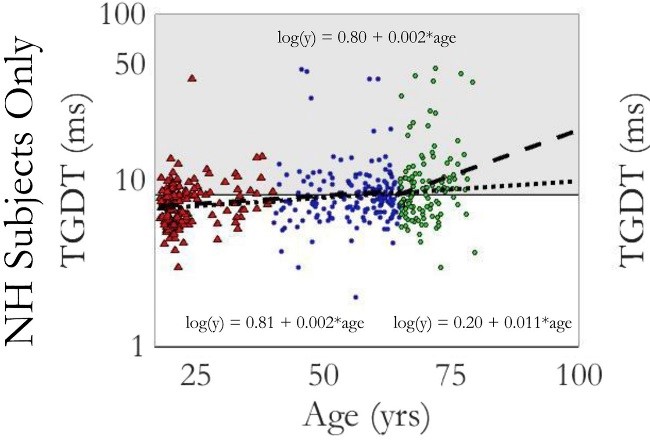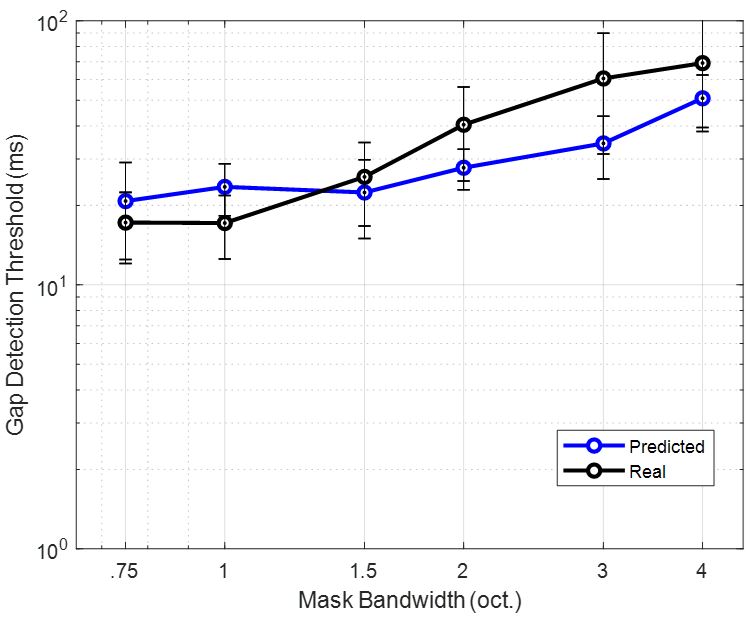Our Research Lab
Temporal Envelope Perception
Our work on this topic dates back to the former lab director, Dr. David Eddins, and his graduate research where he established the independence of temporal envelope perception and carrier frequency region using the temporal gap detection (Eddins et al., 1992) and amplitude modulation detection (Eddins, 1993) paradigms. More recently, we have shown how temporal envelope perception changes with age and differs across gender (Ozmeral et al., 2016). This work used the temporal gap detection paradigm and is based on data from 1041 human subjects ranging in age from 18 to 92 years. Using this large, cross-sectional data set, we were able to investigate how age impacts temporal envelope perception. As seen in the image below, there is huge variability within any age group, but on average temporal gap detection ability decreases about 1 ms per decade of life up to 65 years, and slightly faster beyond that age.
 Remarkably, the same pattern occurs in persons with clinical normal hearing. Finally,
there was a significant difference between male and female subjects, such that gap
detection thresholds were on average 3.5 ms (51%) worse for female subjects than male
subjects.
Remarkably, the same pattern occurs in persons with clinical normal hearing. Finally,
there was a significant difference between male and female subjects, such that gap
detection thresholds were on average 3.5 ms (51%) worse for female subjects than male
subjects.
Gap detection has been used extensively to index temporal envelope perception in quiet. Our ongoing work is focusing on gap detection in background noise to inform our development of better tests of basic auditory processing abilities. The hope is that we can design a gap detection task that is more sensitive to temporal envelope processing deficits than the typical gap detection in quiet task. In a recently completed experiment, we explored the effect of masker bandwidth on temporal gap detection (among other factors in the study). Remarkably, we showed that gap detection thresholds get worse and worse as the masker bandwidth increases well beyond the noise marker carrying the temporal gap. This is the opposite of what is most often observed in investigations of band-widening experiments in psychoacoustics.
 One of the most successful models of auditory temporal envelope processing is the
Modulation Filterbank Model of Dau and colleagues. It has been used to predict thresholds
in many different tasks, including temporal gap detection. To determine whether or
not our unexpected masking effect could be explained by that model, we implemented
the filterbank model in MATLAB and set up the same masking experiment, replacing human
listeners with the model computations. Initially, the model failed to predict the
masker bandwidth effect. However, when we modified the model by summing the output
across all modulation filters, the model performance was nearly identical to our human
subjects. These results indicate that human subjects (and the current model instantiation)
may be subject to obligatory spectral integration in a temporal envelope task such
as gap detection with noise markers. Importantly, the stimulus parameters of this
experiment (0.5 octave gap marker centered at 2000 Hz and masked by a noise one octave
wide) may well provide a rich stimulus for investigating temporal envelope perception
abilities.
One of the most successful models of auditory temporal envelope processing is the
Modulation Filterbank Model of Dau and colleagues. It has been used to predict thresholds
in many different tasks, including temporal gap detection. To determine whether or
not our unexpected masking effect could be explained by that model, we implemented
the filterbank model in MATLAB and set up the same masking experiment, replacing human
listeners with the model computations. Initially, the model failed to predict the
masker bandwidth effect. However, when we modified the model by summing the output
across all modulation filters, the model performance was nearly identical to our human
subjects. These results indicate that human subjects (and the current model instantiation)
may be subject to obligatory spectral integration in a temporal envelope task such
as gap detection with noise markers. Importantly, the stimulus parameters of this
experiment (0.5 octave gap marker centered at 2000 Hz and masked by a noise one octave
wide) may well provide a rich stimulus for investigating temporal envelope perception
abilities.